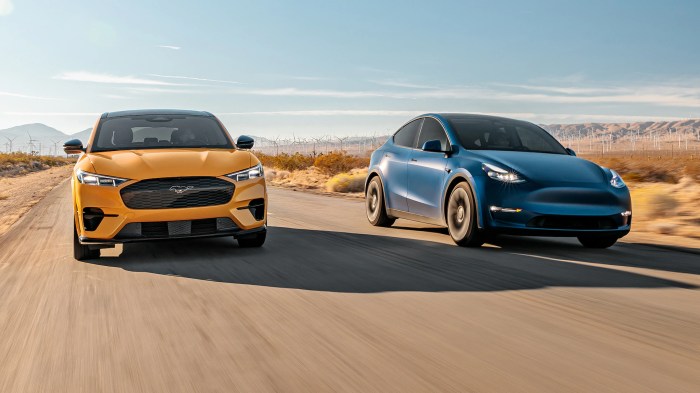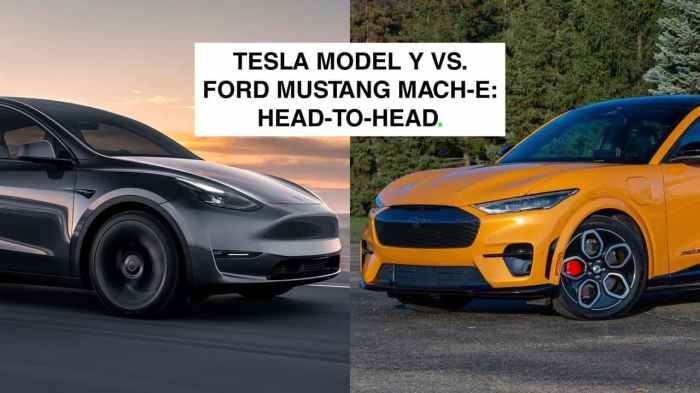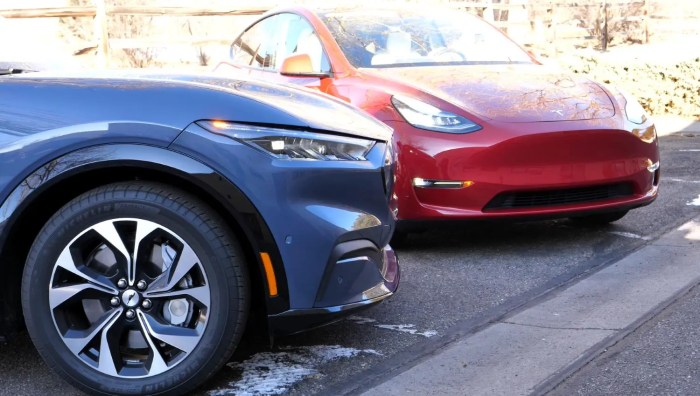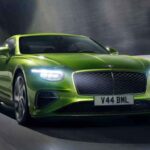Tesla Model Y vs Ford Mustang Mach-E 2025: Choosing between these two all-electric SUVs is a tough call! Both offer impressive performance, sleek designs, and a whole lot of tech. But which one reigns supreme? We’ll dive deep into a head-to-head comparison, looking at everything from acceleration and range to interior features and pricing, to help you decide which EV best fits your needs and lifestyle.
Get ready to buckle up for a comprehensive comparison!
This showdown isn’t just about horsepower and range; it’s about finding the perfect blend of performance, practicality, and tech that aligns with your personal preferences. We’ll explore the nuances of each vehicle, highlighting their strengths and weaknesses to give you a clear picture of which electric SUV comes out on top.
Performance Comparison

Choosing between the Tesla Model Y and the Ford Mustang Mach-E often boils down to personal preference, but a key factor is performance. Both are strong contenders in the electric SUV market, offering impressive acceleration and handling, albeit with some key differences. This section will delve into a detailed comparison of their performance capabilities.
Acceleration
The Model Y and Mach-E offer exhilarating acceleration, though the specific figures vary depending on the trim level. Generally, the Tesla Model Y Performance boasts a quicker 0-60 mph time compared to even the highest-performing Mach-E variant. While precise numbers fluctuate slightly year to year due to software updates and testing variations, the Model Y Performance consistently achieves a 0-60 mph time in the low 3-second range, whereas the Mach-E GT, the quickest Mach-E model, typically clocks in around the mid-3-second range.
This difference, while seemingly small on paper, translates to a noticeable difference in real-world driving.
Powertrain Specifications
The horsepower and torque figures are crucial indicators of performance. Again, these figures depend heavily on the specific trim level. For example, the Tesla Model Y Performance generally boasts significantly higher horsepower and torque than the Ford Mustang Mach-E GT. The difference is even more pronounced when comparing lower-tier trims. While precise numbers are subject to change with model updates, the Model Y’s dual-motor all-wheel-drive system typically provides a substantial advantage in raw power compared to the Mach-E’s offerings.
This translates to a more forceful and immediate acceleration response in the Tesla.
Handling and Braking
Beyond straight-line acceleration, handling and braking are equally important aspects of performance. The Model Y’s lower center of gravity, owing to its battery pack placement, generally contributes to better handling in corners. However, the Mach-E, depending on the trim and optional performance upgrades, can also offer a surprisingly engaging driving experience. Both vehicles benefit from regenerative braking, helping to increase efficiency and providing a unique driving feel.
In terms of braking distance, both vehicles typically perform admirably, though independent testing may reveal slight variations depending on tire type, road conditions, and testing methodology.
Real-World Driving Experience
The real-world driving experience encompasses the overall feel of acceleration, responsiveness, and handling. The Tesla Model Y, especially the Performance variant, delivers an instantaneous and almost violent surge of acceleration. This can feel exhilarating, but some may find it overwhelming. The Mach-E, on the other hand, tends to offer a more linear and progressive acceleration, making it potentially more comfortable for everyday driving.
The steering feel also differs; the Model Y’s steering is often described as more direct and responsive, while the Mach-E’s can feel slightly less connected. Ultimately, the “better” driving experience is subjective and depends on individual preferences.
Range and Charging

Choosing between the Tesla Model Y and the Ford Mustang Mach-E often boils down to individual needs and preferences, and range and charging capabilities are key factors in that decision. Both vehicles offer competitive electric driving experiences, but their approaches to range and charging infrastructure differ significantly.The EPA-estimated range for both vehicles varies depending on the specific trim level and configuration, but generally, the Tesla Model Y tends to offer a slightly longer range than the Ford Mustang Mach-E.
However, real-world range can be affected by driving style, weather conditions, and terrain. This means that while EPA estimates provide a useful benchmark, they don’t always reflect the exact range you’ll experience.
EPA-Estimated Range and Charging Infrastructure
The Tesla Model Y typically boasts a higher EPA-estimated range than the Mach-E, particularly in its Long Range and Performance variants. This advantage stems from Tesla’s long history in EV development and its focus on energy efficiency. However, Ford has made significant improvements in recent years, and the gap is narrowing. The Mustang Mach-E’s extended range versions are increasingly competitive in this area.
Regarding charging infrastructure, Tesla’s Supercharger network provides a significant advantage. This extensive, proprietary network offers convenient and fast charging across the US and increasingly globally. The Mustang Mach-E, on the other hand, relies primarily on the public charging networks like Electrify America, ChargePoint, and others. While these networks are expanding rapidly, they might not offer the same level of ubiquity and reliability as the Tesla Supercharger network, especially in less populated areas.
Charging Times and Costs
Charging times for both vehicles vary greatly depending on the charging method employed. Level 2 charging, typically found at homes and some public stations, provides a slower but more convenient overnight charging solution. DC fast charging, on the other hand, allows for significantly faster replenishment of the battery, ideal for longer journeys. Tesla’s Superchargers are known for their speed, often providing a substantial charge in under an hour.
The Mustang Mach-E, using DC fast chargers from networks like Electrify America, can also achieve rapid charging, although speeds may vary depending on the charger’s capacity and the vehicle’s state of charge.
| Vehicle | Charging Method | Time to 80% | Cost per charge (Estimate) |
|---|---|---|---|
| Tesla Model Y Long Range | Tesla Supercharger (250kW) | ~20-30 minutes | $15-$30 |
| Tesla Model Y Long Range | Level 2 (7kW) | ~8-10 hours | $5-$10 |
| Ford Mustang Mach-E Extended Range | Electrify America (350kW) | ~30-45 minutes | $15-$35 |
| Ford Mustang Mach-E Extended Range | Level 2 (7kW) | ~8-10 hours | $5-$10 |
Note: Charging times and costs are estimates and can vary based on factors like ambient temperature, charger output, battery state of charge, and electricity prices. The cost per charge is a rough estimate based on average electricity prices and charging speeds.
Interior and Technology
Stepping inside the 2025 Tesla Model Y and Ford Mustang Mach-E reveals distinct approaches to interior design and technology integration. While both offer compelling features, their philosophies differ significantly, impacting the overall driving experience. The choice between them ultimately depends on individual preferences for aesthetics, tech integration, and desired features.
Interior Design and Materials
The Model Y prioritizes a minimalist aesthetic. Its interior is characterized by clean lines, a large central touchscreen, and a focus on functionality over ornamentation. Materials tend towards a mix of hard plastics and vegan leatherette, with the overall feel leaning towards modern and efficient rather than luxurious. In contrast, the Mach-E offers a more traditional, albeit modern, interior layout.
It incorporates softer-touch materials in more places, often including real stitching and higher-quality plastics, contributing to a more premium feel, especially in higher trim levels. This difference in material choice and design language translates to a noticeable difference in perceived quality and overall ambiance.
Infotainment Systems and Features
Tesla’s infotainment system, controlled primarily through a massive central touchscreen, is renowned for its responsiveness and seamless integration of various vehicle functions. However, its reliance on a single screen can be overwhelming for some, and the lack of traditional buttons and knobs for climate control and other functions can be distracting, especially for new users. The Mach-E’s system, while also largely touchscreen-based, offers a more traditional approach with physical controls for key functions like climate control.
This system typically integrates seamlessly with smartphone apps and provides a more intuitive user experience for those accustomed to more conventional vehicle interfaces. Both systems offer over-the-air updates, allowing for continuous improvement and the addition of new features.
Driver-Assistance Technologies
Tesla’s Autopilot system is a widely recognized advanced driver-assistance system (ADAS) that offers features like adaptive cruise control, lane keeping assist, and automatic lane changes. However, it’s important to note that Autopilot requires constant driver supervision and is not a fully autonomous driving system. Ford’s BlueCruise is a comparable ADAS offering similar features. Key differences lie in the availability of hands-free driving capabilities and the geographical limitations of each system.
BlueCruise, for example, might only operate on pre-mapped highways, whereas Autopilot’s functionality may be broader, albeit with similar caveats regarding driver attention and responsibility. Both systems are constantly evolving through software updates, improving their capabilities and safety features.
Passenger and Cargo Space
The Model Y and Mach-E offer comparable passenger space for front and rear seat occupants. Both SUVs comfortably accommodate adults in both rows. However, the cargo space varies slightly. The Model Y’s liftback design typically provides a more versatile and spacious cargo area, offering greater flexibility for larger items. The Mach-E, while offering ample space for everyday needs, might have slightly less overall cargo capacity depending on the specific configuration and trim level.
The overall difference in cargo space is generally not dramatic and will likely depend on individual needs and preferences.
Pricing and Features: Tesla Model Y Vs Ford Mustang Mach-E 2025
Choosing between the Tesla Model Y and Ford Mustang Mach-E often comes down to more than just performance and range; the price and included features play a significant role. Both vehicles offer a range of trims, each with its own set of standard features and optional upgrades, making direct comparison crucial for potential buyers. This section breaks down the pricing and feature sets of comparable trims to help you make an informed decision.
Price Comparison of Comparable Trims
Pricing for both the Tesla Model Y and Ford Mustang Mach-E can fluctuate based on current market conditions and any available incentives. However, a general comparison of similarly equipped trims can be made. For example, comparing the Model Y Long Range to the Mach-E Premium AWD provides a reasonable point of reference. Keep in mind that Tesla’s pricing strategy often simplifies trim levels, whereas Ford offers a more traditional approach with distinct trim packages and option packages.
Always check the manufacturer’s website for the most up-to-date pricing information.
Standard Features in Base Trims
The base Model Y and the base Mach-E offer different levels of standard equipment. The Tesla Model Y’s base model typically includes Autopilot features (though the specifics of what’s included in the “base” Autopilot can change), a large touchscreen, and a minimalist interior. The Ford Mustang Mach-E’s base model usually includes a smaller touchscreen, a less advanced driver-assistance system, and potentially fewer standard comfort features.
However, Ford’s base model often includes features like a premium sound system or heated seats that may be considered optional upgrades on the Tesla.
Optional Packages and Add-ons
Both manufacturers offer a range of optional packages and add-ons. Tesla’s options often center around enhanced Autopilot capabilities (Full Self-Driving Capability), performance upgrades (like the Performance Model Y), and interior upgrades (like different wheel options or premium interior materials). Ford, on the other hand, provides a wider variety of optional packages, such as different exterior styling packages, upgraded sound systems, and advanced driver-assistance features.
These optional packages can significantly impact the final price.
So, you’re trying to decide between a Tesla Model Y and a Ford Mustang Mach-E for 2025? Both are great EVs, but one key difference is how aggressive their regenerative braking is. If you find yourself needing more control, you might want to check out how to adjust this feature; learning how to disable it completely is covered in this helpful guide: How To Disable Ev Regenerative Braking.
Understanding regenerative braking is definitely something to consider when comparing these two popular electric SUVs.
Feature Comparison Table
| Feature | Tesla Model Y Cost | Ford Mustang Mach-E Cost | Notes |
|---|---|---|---|
| Base MSRP (Long Range equivalent) | ~$50,000 | ~$50,000 | Prices are approximate and subject to change. |
| Autopilot/Driver-Assist Features | Included (basic Autopilot); Full Self-Driving Capability is an additional cost | Included (Co-Pilot360); Advanced driver-assistance packages are available at extra cost. | Levels of driver assistance vary significantly. |
| Premium Sound System | Optional upgrade | Often standard in higher trims, optional in lower trims | Tesla’s sound system is generally considered to be of high quality even in the base model. |
| Heated Seats | Optional upgrade | Often standard in higher trims, optional in lower trims. | Heating and ventilation features are usually considered optional upgrades in Tesla. |
| Panoramic Sunroof | Standard | Often standard in higher trims, optional in lower trims. | A significant difference in standard features. |
| Exterior Color Options | Limited selection, some colors are additional cost | Wider variety of colors, some colors are additional cost. | Color choices affect pricing in both brands. |
Safety and Reliability
Choosing an electric vehicle often involves considering not only performance and features but also safety and long-term reliability. Both the Tesla Model Y and Ford Mustang Mach-E are relatively new models, so long-term reliability data is still accumulating. However, we can compare their current safety ratings and reported issues to get a clearer picture.Both vehicles boast an impressive suite of safety features, but their performance in crash tests and reported reliability issues vary.
Understanding these differences is crucial for informed decision-making.
Safety Ratings and Features
The Tesla Model Y and Ford Mustang Mach-E have received generally positive safety ratings from organizations like the National Highway Traffic Safety Administration (NHTSA) and the Insurance Institute for Highway Safety (IIHS). However, the specific ratings and the features contributing to those ratings differ. Direct comparison of numerical scores is important, as is a review of the specific safety technologies included.
- Tesla Model Y: The Model Y has consistently scored well in NHTSA crash tests, earning high marks in various categories. The IIHS has also awarded it Top Safety Pick+ status in many of its configurations. This is largely attributed to its robust construction and advanced driver-assistance systems (ADAS).
- Ford Mustang Mach-E: The Mach-E has also performed well in NHTSA and IIHS tests, generally receiving high safety ratings. Specific scores may vary slightly depending on the trim level and year. The Mach-E also includes a comprehensive suite of ADAS features designed to enhance safety.
Here’s a comparison of some key safety features:
| Feature | Tesla Model Y | Ford Mustang Mach-E |
|---|---|---|
| Automatic Emergency Braking (AEB) | Standard | Standard |
| Lane Keeping Assist | Standard | Standard |
| Adaptive Cruise Control | Standard | Standard |
| Blind Spot Monitoring | Standard | Standard |
| Rear Cross-Traffic Alert | Standard | Standard |
Reliability and Recalls, Tesla Model Y vs Ford Mustang Mach-E 2025
Assessing the long-term reliability of both vehicles requires considering reported issues and recalls. While both brands have experienced recalls, the nature and frequency of these events differ. For example, Tesla has faced recalls related to software issues and autopilot functionality, while Ford has experienced recalls related to various mechanical components. It’s crucial to check for the latest recall information from both manufacturers directly before making a purchase.
Warranty Coverage
Understanding the warranty offered by each manufacturer is crucial for long-term ownership. Tesla and Ford offer different warranty structures covering various aspects of the vehicle, including battery and powertrain components. It’s advisable to review the specific terms and conditions of each manufacturer’s warranty to understand the extent of coverage provided. For example, Tesla’s warranty may cover certain components for a longer duration than Ford’s.
A detailed comparison of warranty terms is recommended before committing to a purchase.
So, 2025 is shaping up to be a big year for EVs, especially with the Tesla Model Y and Ford Mustang Mach-E battling it out for market share. To get a sense of how this rivalry will play out, it’s worth checking out the projected Ev Adoption Rates In Texas 2025 , since Texas is a huge market.
Ultimately, the success of both the Model Y and Mach-E will depend on factors beyond just specs – consumer preference and overall EV market growth will be key.
Exterior Styling and Design
The Tesla Model Y and Ford Mustang Mach-E represent distinct approaches to electric SUV design, appealing to different aesthetic preferences and buyer demographics. While both are undeniably modern and sleek, their styling cues reflect differing design philosophies and target markets. The Model Y leans towards a minimalist, almost futuristic aesthetic, while the Mach-E incorporates more traditional SUV styling elements with a nod to its namesake’s sporty heritage.The Model Y’s exterior is characterized by its clean lines, flush door handles, and a generally understated profile.
Its smooth surfaces and lack of excessive ornamentation contribute to a sense of aerodynamic efficiency and sophistication. In contrast, the Mach-E features a more sculpted and muscular body, with pronounced wheel arches and a more aggressive front fascia. The incorporation of elements reminiscent of the classic Mustang, such as the fastback roofline and the three-bar taillights, aims to create a sense of heritage and sporty appeal.
Exterior Color Options
Tesla offers a range of solid and metallic paint options for the Model Y, typically including colors like Pearl White Multi-Coat, Solid Black, Midnight Silver Metallic, and Deep Blue Metallic. Specific availability can vary by region and production time. Ford, for the Mach-E, provides a broader palette, often including options like Grabber Blue Metallic, Iconic Silver Metallic, Rapid Red Metallic Tinted Clearcoat, and Star White Metallic Tri-Coat.
Again, precise color offerings can fluctuate depending on the model year and market. Both manufacturers offer premium paint options at an additional cost.
Aesthetic Appeal Comparison
The Model Y’s minimalist design will likely appeal to buyers who prioritize clean lines and a technologically advanced aesthetic. Its understated elegance might be considered more sophisticated and less flashy than the Mach-E. The Mach-E, on the other hand, with its sportier styling and nods to the Mustang heritage, is likely to attract buyers who value a more dynamic and expressive design.
The choice ultimately comes down to personal preference; some may find the Model Y’s simplicity refreshing, while others may prefer the Mach-E’s more assertive appearance.
Design Philosophy and Target Audience
Tesla’s design philosophy for the Model Y reflects its broader brand identity: a focus on technological innovation and minimalist aesthetics. The Model Y’s design is targeted towards a technologically savvy customer base who values efficiency, functionality, and a modern, uncluttered design. Ford’s design approach for the Mach-E, conversely, aims to blend electric vehicle technology with the established appeal of the Mustang brand.
This strategy seeks to attract a broader audience, including those familiar with and drawn to the Mustang’s sporty heritage, while simultaneously introducing them to the world of electric vehicles. This suggests that Ford’s target audience might be slightly more diverse than Tesla’s, encompassing both tech enthusiasts and those looking for a stylish and performance-oriented electric SUV with a recognizable brand identity.
Environmental Impact

The environmental impact of electric vehicles (EVs) like the Tesla Model Y and Ford Mustang Mach-E is a complex issue, extending beyond simply eliminating tailpipe emissions. Manufacturing, battery sourcing, energy consumption, and end-of-life management all contribute to their overall carbon footprint. While EVs offer significant advantages over gasoline cars, a comprehensive comparison of these factors is crucial for a complete understanding of their environmental performance.The manufacturing process of both the Model Y and Mach-E involves significant energy consumption and associated emissions, primarily from the mining and processing of raw materials for batteries and vehicle components.
However, the environmental impact varies depending on the sourcing of materials and the efficiency of manufacturing processes. Furthermore, the electricity used in the manufacturing process can vary greatly depending on the source (e.g., renewable energy vs. fossil fuels).
Manufacturing Carbon Footprint
Studies comparing the manufacturing carbon footprint of EVs and gasoline vehicles show mixed results, with some indicating that EVs have a higher initial carbon footprint due to battery production. However, these studies often vary in methodology and assumptions. Factors such as the energy mix used in manufacturing and the efficiency of the manufacturing process significantly impact the final carbon footprint calculation.
For example, a study by the International Council on Clean Transportation (ICCT) suggests that the manufacturing emissions for EVs are higher than for comparable gasoline vehicles, but the overall lifecycle emissions are lower due to the lack of tailpipe emissions. It’s important to note that these figures are constantly evolving as manufacturing processes improve and renewable energy sources become more prevalent.
Environmental Benefits of Electric Vehicles
The primary environmental benefit of EVs is the elimination of tailpipe emissions during operation. This significantly reduces air pollution in urban areas, contributing to improved public health. Furthermore, EVs can utilize electricity generated from renewable sources, further decreasing their overall carbon footprint. In contrast, gasoline-powered vehicles release greenhouse gases and pollutants directly into the atmosphere, contributing to climate change and air quality issues.
The reduction in reliance on fossil fuels also enhances energy security and reduces dependence on volatile global oil markets. The extent of these benefits, however, depends on the electricity source powering the EV. For example, an EV charged primarily with electricity generated from coal plants would have a significantly higher carbon footprint than one charged with renewable energy.
Battery Sourcing and Recycling
Tesla and Ford both utilize lithium-ion batteries in their EVs. The sourcing of the raw materials for these batteries, including lithium, cobalt, nickel, and manganese, raises significant environmental and social concerns. Mining these materials can lead to habitat destruction, water pollution, and human rights violations in some regions. Both companies are actively pursuing more sustainable sourcing practices, including collaborations with suppliers committed to responsible mining and ethical labor standards.
Recycling battery components is also crucial to mitigating the environmental impact. Tesla has invested in battery recycling technologies, aiming to recover valuable materials and reduce waste. Ford has also Artikeld plans for battery recycling and plans to partner with recycling companies to manage end-of-life batteries. The effectiveness of these recycling programs and the long-term environmental impact of battery disposal remain areas of ongoing research and development.
Lifecycle Energy Consumption and Emissions
The energy consumption and emissions associated with an EV’s lifecycle include manufacturing, operation, and end-of-life management. While EVs have zero tailpipe emissions, their overall carbon footprint is influenced by the electricity source used for charging and the energy intensity of the manufacturing process. A well-to-wheel analysis considers the entire energy pathway, from electricity generation to vehicle operation, providing a more comprehensive picture of an EV’s environmental impact compared to a gasoline vehicle.
Studies using this analysis generally show that EVs have lower lifecycle greenhouse gas emissions than gasoline vehicles, particularly when charged with renewable energy. However, this advantage diminishes when the electricity grid relies heavily on fossil fuels. The lifecycle emissions of the Model Y and Mach-E will vary depending on factors such as the geographic location, the electricity mix of the power grid, and driving patterns.
Outcome Summary
Ultimately, the “better” EV between the Tesla Model Y and Ford Mustang Mach-E in 2025 depends entirely on your priorities. The Model Y boasts superior performance and a more established charging network, while the Mach-E offers a more traditional SUV driving experience and potentially better value depending on the trim level. Weighing the pros and cons of each—from range and charging to tech features and price—is key to making the right choice for your individual needs.
Happy driving!









